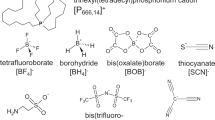Play all audios:

ABSTRACT THE vitrification of phosphoric acids is relatively easy, a glass often being formed simply on cooling from the liquid melt. Special procedures, however, are required to crystallise
these materials. The glass transition temperature, _T_g, is the temperature above which there is relatively rapid molecular motion; below _T_g translational motion of molecules is
inhibited. In standard texts1 it is stated that the glass transition temperature of orthophosphoric acid, H3PO4, is −121 °C. The source of the determination is not always cited but it seems
to be that of Kobeko _et al._2 who determined _T_g from measurements of the temperature dependence of the electrical conductivity of phosphoric acid. Although published almost 40 yr ago
there does not seem to have been a more recent determination. We present here evidence from broad-line nuclear magnetic resonance (NMR) studies that the estimate of −121 °C for the glass
transition temperature of orthophosphoric acid is wrong. A discussion of the nterpretation of the electrical conductivity of phosphoric acid would be in appropriate beyond observing that
several different ionic or molecular processes may be responsible for the transfer of electrical charges. Thus, an unambiguous determination of a glass transition from such data may be far
from straightforward. Access through your institution Buy or subscribe This is a preview of subscription content, access via your institution ACCESS OPTIONS Access through your institution
Subscribe to this journal Receive 51 print issues and online access $199.00 per year only $3.90 per issue Learn more Buy this article * Purchase on SpringerLink * Instant access to full
article PDF Buy now Prices may be subject to local taxes which are calculated during checkout ADDITIONAL ACCESS OPTIONS: * Log in * Learn about institutional subscriptions * Read our FAQs *
Contact customer support SIMILAR CONTENT BEING VIEWED BY OTHERS PRESSURE-INDUCED LIQUID-LIQUID TRANSITION IN A FAMILY OF IONIC MATERIALS Article Open access 15 March 2022 CHARACTERIZATION OF
THE HIGH-PRESSURE AND HIGH-TEMPERATURE PHASE DIAGRAM AND EQUATION OF STATE OF CHROMIUM Article Open access 25 April 2022 THERMAL EXPANSION AND THE GLASS TRANSITION Article Open access 06
February 2023 REFERENCES * Toy, A. D. F., _The Chemistry of Phosphorus_, 482 (Pergamon, Oxford, 1975). Google Scholar * Kobeko, P. P., Kuvshinskii, E. V., and Shishkin, N. J., _J. phys.
Chem., Mosc._, 9, 387 (1937). CAS Google Scholar * Ellis, B., and McDonald, M. P., _J. non-cryst. Solids_, 1, 186 (1969). Article CAS ADS Google Scholar * Ellis, B., in _Amorphous
Materials_ (edit. by Douglas, R. W., and Ellis, B.), 357 (Wiley, New York, 1972). Google Scholar * Gee, G., _Amorphous Materials_ (edit. by Douglas, R. W., and Ellis, B.), 115 (Wiley, New
York, 1972). Google Scholar * Yates, M. J., thesis, Univ. Sheffield (1973). * Smith, R. J., thesis, Univ. Sheffield (1976). * Maklakov, A. I., and Pimenov, G. G., _J. polym. Sci.,
U.S.S.R._, 15, 123 (1973). Article Google Scholar * McCall, D. W., _Acc. chem. Res._, 4, 223 (1971). Article CAS Google Scholar * Bondi, A., _Physical Properties of Molecular Crystals,
Liquids and Glasses_, 379 (Wiley, New York, 1968). Google Scholar * Eisenberg, A., Farb, H., and Cool, L. G., _J. polym. Sci._, A-2, 4, 855 (1966). Google Scholar Download references
AUTHOR INFORMATION AUTHORS AND AFFILIATIONS * Department of Ceramics, Glasses and Polymers, The University of Sheffield, Sheffield, S10 2TZ, UK BRYAN ELLIS Authors * BRYAN ELLIS View author
publications You can also search for this author inPubMed Google Scholar RIGHTS AND PERMISSIONS Reprints and permissions ABOUT THIS ARTICLE CITE THIS ARTICLE ELLIS, B. The glass transition
temperatures of phosphoric acids. _Nature_ 263, 674–676 (1976). https://doi.org/10.1038/263674a0 Download citation * Received: 24 May 1976 * Accepted: 10 September 1976 * Published: 01
October 1976 * Issue Date: 21 October 1976 * DOI: https://doi.org/10.1038/263674a0 SHARE THIS ARTICLE Anyone you share the following link with will be able to read this content: Get
shareable link Sorry, a shareable link is not currently available for this article. Copy to clipboard Provided by the Springer Nature SharedIt content-sharing initiative
